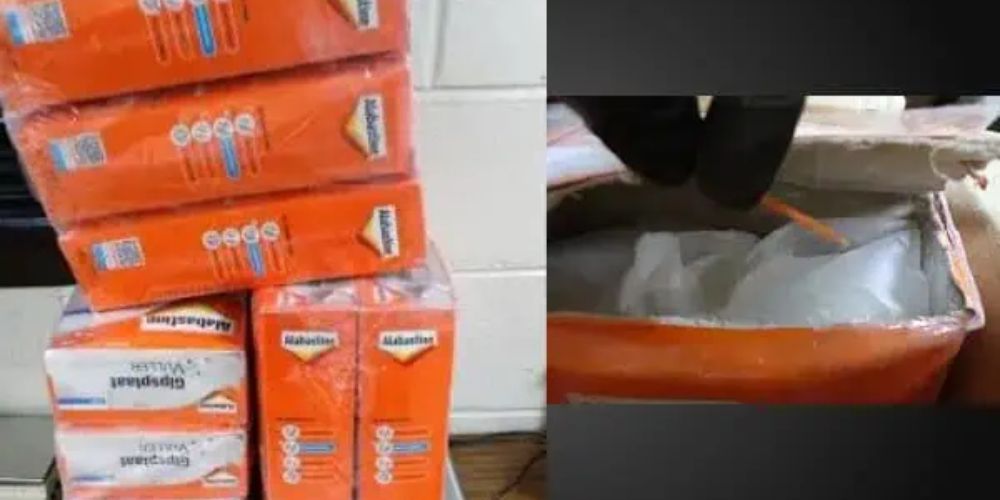Federal officials are warning of a sophisticated and growing trend in drug trafficking, as international air cargo becomes the major route for large-scale ketamine shipments from Europe to South Florida. This developing pattern has piqued the interest of US Customs and Border Protection (CBP), which reports a considerable bypass of established smuggling corridors.
CBP officers in Philadelphia recently seized nearly 73 pounds of deadly ketamine, which had been smuggled from Europe to South Florida via express delivery shipments. This is part of a larger pattern; just last month, CBP inspectors in Philadelphia seized five packages containing 57 pounds of ketamine hydrochloride.
In these most recent incidents, the tactics of concealment were extremely deceptive. On July 5, CBP inspectors intercepted a little more than 46 pounds in a cargo from France disguised as an “industrial air filter HEPA air filter.” Days later, on July 9, officers confiscated another 26 pounds, 11 ounces from a cargo originating in Germany, disguised as a “Mercedes E class headlight right W2.” Both supplies were eventually delivered to locations in Broward County, Florida, a region known for its thriving club scene.
In each case, authorities uncovered a white, crystalline material concealed among other packing. They quickly examined the drug with handheld elemental isotope analysis equipment, which revealed it to be ketamine hydrochloride. These recent ketamine seizures totaled 72 pounds, 13 ounces, and had an estimated street value of $1.8 million.
“Ketamine is a very dangerous anesthetic that can seriously harm abusers and unsuspecting victims, and so it’s an illicit drug that Customs and Border Protection officers take immense pleasure at intercepting before it can reach our communities,” said Cleatus P. Hunt, Jr., Area Port Director for CBP’s Area Port of Philadelphia. “CBP remains committed to combatting drug trafficking organizations by seizing their poisonous shipments at our nation’s ports of entry.”
The United States Drug Enforcement Administration (DEA) classifies ketamine hydrochloride as a Schedule III non-narcotic substance under the Controlled Substances Act. While it is legal in both human and veterinary medicine to cause drowsiness, immobility, and pain alleviation, it is widely abused on the streets. There, it’s generally known as “Special K, Donkey Dust, and Cat Killer,” and it’s frequently smoked, snorted, or blended into drinks. Users desire its capacity to produce dissociative experiences and hallucinations comparable to phencyclidine (PCP).
Authorities are concerned because ketamine is routinely cut or combined with other harmful substances, such as ecstasy, and is commonly connected with raves and dance clubs. Overdoses can cause major health problems such as nausea, rapid heart rate, unconsciousness, convulsions, and even respiratory failure. Ketamine has also been used by sexual predators to render their victims unconscious during sexual attacks.
Philadelphia CBP officials have seized seven shipments totaling about 130 pounds of deadly ketamine in the previous six weeks. This kind of smuggling, which uses international express mail and fraudulent product labeling, poses a new challenge for law enforcement, making detection far more difficult than the traditional flow of drugs like fentanyl or methamphetamine across land borders.
While ketamine enters the United States by air from Europe, the US-Mexico border remains a hub for other hazardous substances. In a second instance on Friday, July 18, CBP officers in El Paso, Texas, captured a US citizen who was attempting to transport fentanyl by concealing it within his body. The man was detained at the Bridge of the Americas pedestrian crossing when a K-9 unit detected the presence of drugs. A later medical scan discovered two condom-wrapped packages within, one containing powdered fentanyl and the other tablets, totaling nearly 132 grams of the lethal synthetic opioid.
Authorities underline the significant danger posed by such smuggling methods, stating that traffickers are constantly crossing borders by air, sea, and land to deliver illicit narcotics into the country. On average, CBP officers and agents recover 1,571 pounds of drugs every day at US air, sea, and land ports of entry, including 78 pounds of fentanyl.
CBP’s border security duty, overseen by officers and agriculture specialists from the Office of Field Operations at the country’s ports of entry, includes inspecting foreign travelers and goods. Their unwavering efforts are aimed at intercepting illegal narcotics, unreported currency, weapons, counterfeit consumer goods, prohibited agriculture, invasive weeds and pests, and other illicit products that could endanger the American people, businesses, and the nation’s security and economic vitality.




